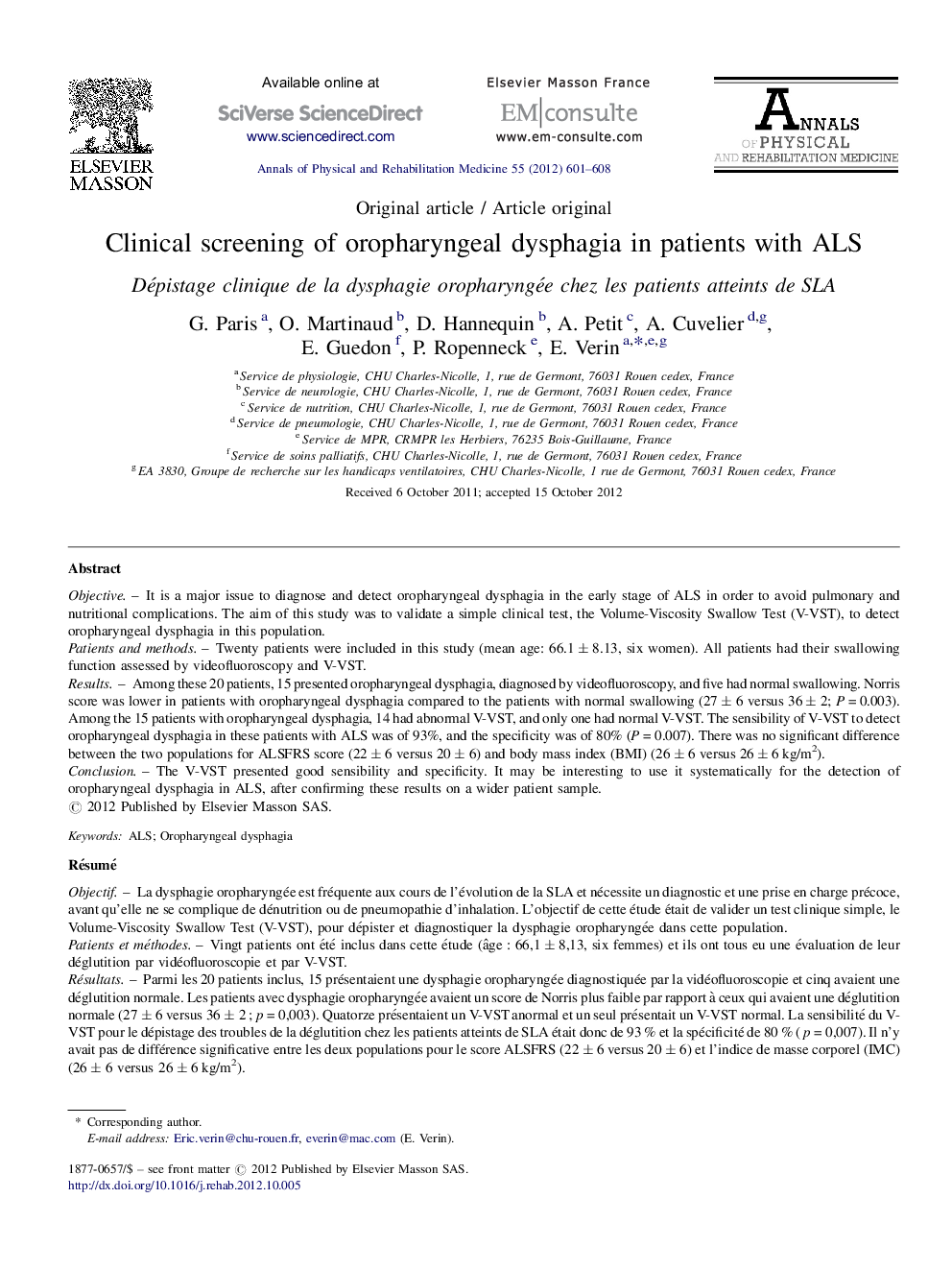| کد مقاله | کد نشریه | سال انتشار | مقاله انگلیسی | نسخه تمام متن |
|---|---|---|---|---|
| 6204348 | 1603322 | 2012 | 8 صفحه PDF | دانلود رایگان |

ObjectiveIt is a major issue to diagnose and detect oropharyngeal dysphagia in the early stage of ALS in order to avoid pulmonary and nutritional complications. The aim of this study was to validate a simple clinical test, the Volume-Viscosity Swallow Test (V-VST), to detect oropharyngeal dysphagia in this population.Patients and methodsTwenty patients were included in this study (mean age: 66.1 ± 8.13, six women). All patients had their swallowing function assessed by videofluoroscopy and V-VST.ResultsAmong these 20 patients, 15 presented oropharyngeal dysphagia, diagnosed by videofluoroscopy, and five had normal swallowing. Norris score was lower in patients with oropharyngeal dysphagia compared to the patients with normal swallowing (27 ± 6 versus 36 ± 2; P = 0.003). Among the 15 patients with oropharyngeal dysphagia, 14 had abnormal V-VST, and only one had normal V-VST. The sensibility of V-VST to detect oropharyngeal dysphagia in these patients with ALS was of 93%, and the specificity was of 80% (P = 0.007). There was no significant difference between the two populations for ALSFRS score (22 ± 6 versus 20 ± 6) and body mass index (BMI) (26 ± 6 versus 26 ± 6 kg/m2).ConclusionThe V-VST presented good sensibility and specificity. It may be interesting to use it systematically for the detection of oropharyngeal dysphagia in ALS, after confirming these results on a wider patient sample.
RésuméObjectifLa dysphagie oropharyngée est fréquente aux cours de l'évolution de la SLA et nécessite un diagnostic et une prise en charge précoce, avant qu'elle ne se complique de dénutrition ou de pneumopathie d'inhalation. L'objectif de cette étude était de valider un test clinique simple, le Volume-Viscosity Swallow Test (V-VST), pour dépister et diagnostiquer la dysphagie oropharyngée dans cette population.Patients et méthodesVingt patients ont été inclus dans cette étude (âge : 66,1 ± 8,13, six femmes) et ils ont tous eu une évaluation de leur déglutition par vidéofluoroscopie et par V-VST.RésultatsParmi les 20 patients inclus, 15 présentaient une dysphagie oropharyngée diagnostiquée par la vidéofluoroscopie et cinq avaient une déglutition normale. Les patients avec dysphagie oropharyngée avaient un score de Norris plus faible par rapport à ceux qui avaient une déglutition normale (27 ± 6 versus 36 ± 2 ; p = 0,003). Quatorze présentaient un V-VST anormal et un seul présentait un V-VST normal. La sensibilité du V-VST pour le dépistage des troubles de la déglutition chez les patients atteints de SLA était donc de 93 % et la spécificité de 80 % (p = 0,007). Il n'y avait pas de différence significative entre les deux populations pour le score ALSFRS (22 ± 6 versus 20 ± 6) et l'indice de masse corporel (IMC) (26 ± 6 versus 26 ± 6 kg/m2).ConclusionLe V-VST présentant une bonne sensibilité et spécificité, il pourrait être intéressant de le proposer pour le diagnostic précoce de la dysphagie oropharyngée chez les patients atteints de SLA, après avoir confirmé ces résultats sur un échantillon plus large.
Journal: Annals of Physical and Rehabilitation Medicine - Volume 55, Issues 9â10, December 2012, Pages 601-608